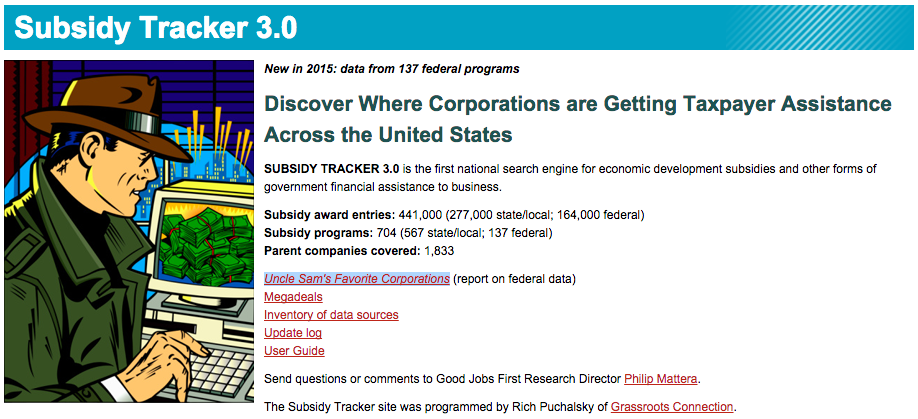Good Jobs First identifies government’s favorite corporations

Good Jobs First’s new study, Uncle Sam’s Favorite Corporations, provides 22 pages of analysis and statistics showing the extent to which the federal government — Congress, which funds programs and the executive branch, which distributes it — favors large corporate interests in doling out taxpayer money. The accompanying database, Subsidy Tracker 3.0, allows users to dig down into the data, looking up specific companies and programs at the federal level. (Of course, Subsidy Tracker has long had state and local data as well.)
It’s an amazing resource that sheds light on the benefits corporations derive from government, and a reminder that who benefits from Washington largesse isn’t always obvious. Here, for example, are “federal grant/allocated tax credit programs” that Good Jobs First included in the analysis. Over the last 15 years, the Food for Progress program, set up by the U.S. Department of Agriculture to aid developing countries and emerging democracies, provided subsidies worth more than $72 million, including millions to large corporations like Maersk Lines Ltd., the U.S. subsidiary of the Maersk Group, and Archer Daniel Midlands, the agricultural giant.
Overall, the federal government provided $68 billion in grants and special tax credits to businesses over the last 15 years, the study’s authors, Philip Mattera and Kasia Tarczynska, conclude, with the largest corporations capturing two-thirds of them.
Good Jobs First includes data from 137 programs, but there’s a consistent pattern as one navigates them. Companies receiving federal grants for “basic scientific research” include defense giants General Dynamics and BAE Systems. Companies receiving federal grants for Basic and Applied Scientific Research include defense giant Lockheed Martin and auto maker General Motors. Companies receiving federal grants for “basic, applied and advanced research in science and engineering” include defense giants Boeing, Raytheon, General Dynamics and BAE Systems. Perhaps that’s not surprising, since all three programs are run out of the Department of Defense, but it’s a little breathtaking to think that taxpayers sponsor research done by defense contractors that will potentially contribute to new weapons programs that will be paid for by taxpayers.
One of the larger subsidies is the Department of Energy’s Fossil Energy Research and Development program, which provides funds to Southern Company, which owns coal and nuclear electrical generation facilities, and Archer Daniels Midland, a big proponent of ethanol. Larger still is the section 1603 program, in which the Treasury Department offers grants to companies engaged in alternative energy generation — this green incentive has been tapped by companies to the tune of $23.3 billion, with beneficiaries that include NextEra Energy, Duke Energy and British Petroleum.
Another source of government aid, the Overseas Private Investment Corporation offers political risk insurance — that is, guarantees to make companies that invest in unstable countries abroad — to giant banks like Citigroup and Bank of America and manufacturers like Caterpillar and General Electric. OPIC also puts taxpayers on the hook should entertainment conglomerate Viacom’s Russian MTV subsidiary run afoul of Vladimir Putin’s government.
Some subsidies have just one beneficiary, like the Helium Resource Management grants, which all go to the Cliffside Refiners Limited Partnership. The government created that partnership — a consortium of Air Products, Linde, Kinder Morgan and Praxair — to privatize the nation’s helium reserve, then financed it with public money.
For those serious about understanding how deeply entwined the private and public sector are, the Subsidy Tracker 3.0 is a great place to start.

